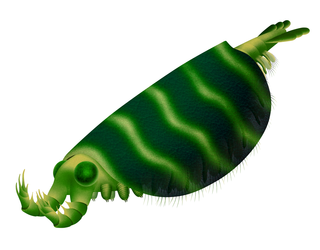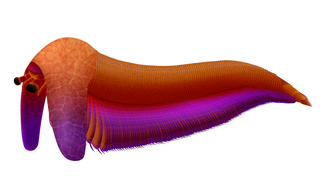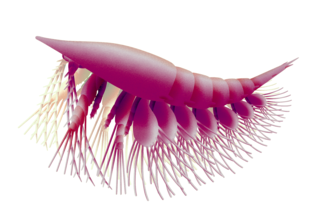
Sanctacaris is a Middle Cambrian arthropod from the Burgess Shale of British Columbia. It was most famously regarded as a stem-group chelicerate, a group which includes horseshoe crabs, spiders and scorpions, although subsequent phylogenetic studies have not always supported this conclusion. Its chelicerate affinities regain support in later observations, alongside the reassignment of Habelia optata as a sanctacaridid-related basal chelicerate. It has been placed as a member of the extinct family Sanctacarididae alongside Wisangocaris and Utahcaris.

Sidneyia is an extinct arthropod known from fossils found from the Early to the Mid Cambrian of China and the Mid Cambrian Burgess Shale of British Columbia, Canada.

Canadaspis is an extinct genus of bivalved Cambrian arthropod, known from North America and China. They are thought to have been benthic feeders that moved mainly by walking and possibly used its biramous appendages to stir mud in search of food. They have been placed within the Hymenocarina, which includes other bivalved Cambrian arthropods.

Waptia is an extinct genus of arthropod from the Middle Cambrian of North America. It grew to a length of 6.65 cm (3 in), and had a large bivalved carapace and a segmented body terminating into a pair of tail flaps. It was an active swimmer and likely a predator of soft-bodied prey. It is also one of the oldest animals with direct evidence of brood care. Waptia fieldensis is the only species classified under the genus Waptia, and is known from the Burgess Shale Lagerstätte of British Columbia, Canada. Specimens of Waptia are also known from the Spence Shale of Utah, United States.

Misszhouia is a genus of small to average sized marine trilobite-like arthropods within the Naraoiidae family, that lived during the early Cambrian period. The species are M. longicaudata, from the Maotianshan Shales, described in 1985, and M. canadensis, from the Burgess Shale and described in 2018, although later species may belongs to genus Naraoia instead.

Pambdelurion is an extinct genus of panarthropod from the Cambrian aged Sirius Passet site in northern Greenland. Like the morphologically similar Kerygmachela from the same locality, Pambdelurion is thought to be closely related to arthropods, combining characteristics of "lobopodians" with those of primitive arthropods.

Habelia is a genus of extinct arthropod from the Middle Cambrian, thought to be one of the earliest known relatives of chelicerates. Its fossils have been found in the Burgess Shale in British Columbia, Canada. Fifty-four specimens of Habelia are known from the Greater Phyllopod bed, where they comprise 0.1% of the community.

Branchiocaris is an extinct genus of Cambrian bivalved arthropod. The type and best known species, Branchiocaris pretiosa, was described from the Burgess Shale of British Columbia, Canada, in 1929, originally placed in Protocaris, and was placed into its own distinct genus by Briggs in 1976. Several other possible species have been described from Cambrian deposits in China, and it is also possibly known from Cambrian deposits in Utah. Branchiocaris pretiosa is around 80–90 millimetres (3.1–3.5 in) in length, with a highly segmented trunk, consisting of at least 44 ring-like segments, terminating in a forked tail telson. At the front of the animal is a pair of short segmented tapered antennules with at least 20 segments, as well as a pair of claw appendages. It was likely an active swimmer, and used the claw appendages to bring food to the mouth.

Megacheira is an extinct class of predatory arthropods defined by their possession of spined "great appendages". Their taxonomic position is controversial, with studies either considering them stem-group euarthropods, or stem-group chelicerates. The homology of the great appendages to the cephalic appendages of other arthropods is also controversial. Uncontested members of the group were present in marine environments worldwide from the lower to middle Cambrian.

Tuzoia is an extinct genus of large bivalved arthropod known from Early to Middle Cambrian marine environments from what is now North America, Australia, China, Europe and Siberia. The large, domed carapace reached lengths of 180 millimetres (7.1 in), making them amongst the largest known Cambrian arthropods.

Plenocaris plena is a Cambrian arthropod with a bivalved carapace, and is known from the Burgess shale and Chengjiang. Originally described as a species of Yohoia by Walcott in 1912, it was placed into its own genus in 1974.

Haikoucaris is a genus of megacheiran arthropod that contains the single species Haikoucaris ercaiensis. It was discovered in the Cambrian Chengjiang biota of China.

Primicaris is genus of Cambrian arthropod from the Chengjiang biota of China and the Burgess Shale of Canada. It contains a single described species, P. larvaformis.

Marble Canyon is a canyon surrounding Tokumm Creek just above its confluence with the Vermilion River, at the north end of Kootenay National Park in the Canadian Rockies of British Columbia, Canada. South of Marble Canyon on Highway 93 is Numa Falls on the Vermillion River.

Kootenichela deppi is an extinct arthropod described from the Middle Cambrian of the Kootenay National Park, Canada. It is originally considered to be a member of "great appendage arthropods", although subsequent studies questioned its affinity. Kootenichela appears to be the sister taxon of Worthenella, from cladistic analysis.

Hymenocarina is an order of extinct arthropods known from the Cambrian. They possess bivalved carapaces, typically with exposed posteriors. Members of the group are morphologically diverse and had a variety of ecologies, including as filter feeders and as predators. Recent research has generally considered them to be stem or crown group members of Mandibulata, due the presence of mandibles in at least some species.

Kylinxia is a genus of extinct arthropod described in 2020. It was described from six specimens discovered in Yu'anshan Formation in southern China. The specimens are assigned to one species Kylinxia zhangi. Dated to 518 million years, the fossils falls under the Cambrian period. Announcing the discovery on 4 November 2020 at a press conference, Zeng Han of the Nanjing Institute of Geology and Paleontology, said that the animal "bridges the evolutionary gap from Anomalocaris to true arthropods and forms a key ‘missing link’ in the origin of arthropods," which was "predicted by Darwin’s evolutionary theory." The same day the formal description was published in Nature.

Deuteropoda is a proposed clade of arthropods whose members are distinguished from more basal stem-group arthropods like radiodonts by an anatomical reorganization of the head region, namely the appearance of a differentiated first appendage pair, a multisegmented head, a hypostome/labrum complex, and by bearing pairs of segmented biramous limbs.

Balhuticaris is a genus of extinct bivalved hymenocarine arthropod that lived in the Cambrian aged Burgess Shale in what is now British Columbia around 506 million years ago. This extremely multisegmented arthropod is the largest member of the group, and it was even one of the largest animals of the Cambrian, with individuals reaching lengths of 245 mm (9 in). Fossils of this animal suggests that gigantism occurred in more groups of Arthropoda than had been previously thought. It also presents the possibility that bivalved arthropods were very diverse, and filled in a lot of ecological niches.

Oelandocaris is an extinct genus of stem-mandibulate, or possibly a megacheiran, within the monotypic family Oelandocarididae.





















